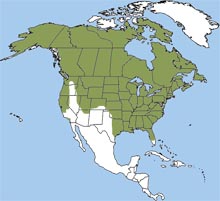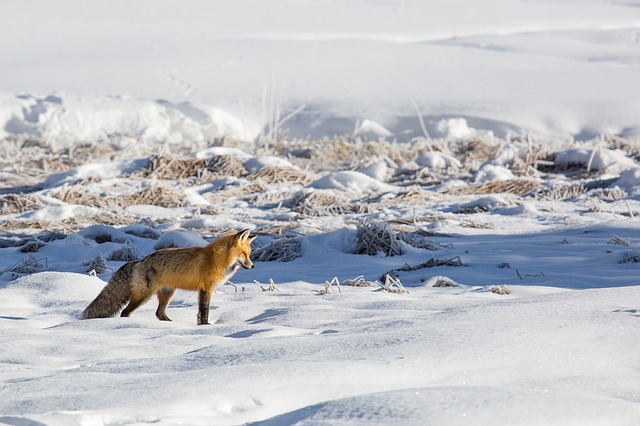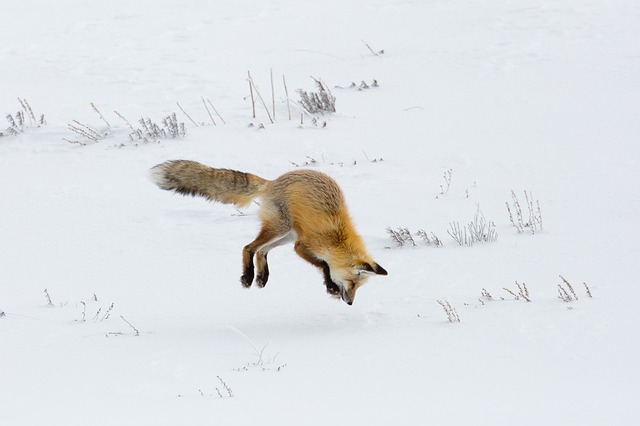Updated May 9, 2025
by Ame Vanorio
We are home to two fantastic fox species: the Gray Fox and the Red Fox. While both belong to the Canidae Family they are distinct cousins from different branches on the tree (note the different scientific names).
Foxes are a delightful part of folklore and have a well-earned reputation for being cunning and sly. They are very intelligent and a tad sneaky!
So as an animal mom, I should not pick favorites. BUT…. I think it's obvious that I love foxes. Foxes are my Native American spirit animal and have captivated me since I was a small child. I had several blinds on the farm where I unobtrusively watch a fox den for a study.
In this article, we explore the biology of the fox, foxes in urban areas, the fox in literature, and what humans can do to help the fox as well as protect their pets and livestock.
The Red Fox
The Red fox (Vulpes vulpes) is the most widely distributed carnivore in the world. It is also considered an invasive species in many countries. The red fox originated in Eurasia and first came into North America during the Wisconsin Glacial Episode some 25,000 years ago.
Europeans brought the European Red Fox over from Europe during colonial days for sports hunting. They quickly spread and now inhabit most areas in the continental USA.
Its current range includes all of the Northern Hemisphere, from the Arctic Circle to North Africa to Central America to the Asiatic steppes. It’s even in Australia, where it’s considered an invasive species.
Red foxes can be found everywhere from downtown Chicago to rural mountain regions. They are least likely to be found in the desert regions of the southwest.
The Red fox has red fur along the face, sides of the body, back, and tail. The throat, chin, belly, and tip of the tail are white or greyish-white in color. The large pointy ears are tipped with black and they have black feet.
The Red fox has a beautiful, long, bushy tail which is sometimes two-thirds of its body length. The tail provides balance, keeps the face warm during winter, and is used in communication.
They share overlapping ranges across North America. However, red foxes often dominate open habitats, while gray foxes stick to wooded areas. The maps below show the Red Fox US territory on the left and the Gray Fox US territory on the right.
Photos courtesy of www.nhpbs.org
The Gray Fox
The Gray fox (Urocyon cinereoargenteus) evolved during the Pliocene Era about 3.6 million years ago. Gray foxes are smaller than reds, darker in color, and have shorter legs.
The gray fox, averages 7 to 14 pounds, is notable for its grizzled gray coat with reddish patches on the chest and sides, and a distinctive black stripe down its tail.
They are more likely to inhabit woodlands in parks and rural areas. They move around more so than the red fox.
The gray fox has hooked claws which are very adapted to climbing trees. This works well as an escape from predators such as the coyote and the domestic dog.
Gray foxes have a black-tipped tail which is one way to tell the difference between them and the white-tipped tail of the Red Fox.
Grey foxes are much less common and more reclusive than the red fox. They are protected in many states.
Red Fox Vs. Gray Fox
Prior to European colonization of North America, the red fox was found primarily in boreal forest and the gray fox in deciduous forest. Humans have pushed the species closer together with urbanization. In regions where both species coexist, interactions are generally characterized by avoidance rather than direct conflict.
However, habitat fragmentation and urban expansion has lead to increased encounters. Red foxes are larger but gray foxes are more aggressive.
Versus coyotes
Additionally, both species face competition from larger predators like coyotes. Coyotes can displace fox populations, pushing them into less suitable habitats. Gray foxes, with their climbing ability and flexible diet, may better adapt to such pressures compared to red foxes.
They compete for the same food. And a coyote will on occasion kill foxes. A coyote would likely win against a fox due to its larger size and strength. While foxes are agile and cunning, the coyote's superior physical attributes, including bite force and ability to hunt in pairs, give it a significant advantage in a conflict.
Versus bobcats
In the age old argument of cat vs dog the bobcat is another competitor and potential conflict. Bobcats, as larger, more powerful carnivores, tend to have the advantage in a head-to-head confrontation with foxes. However, foxes can be surprisingly agile and cunning, potentially giving them the upper hand in certain situations.
Fox Senses
Foxes have wonderful senses.
Their hearing is extraordinary. They have large ears which they can pivot towards sounds. They can hear a mouse squeak 100 ft. away or one four feet under the snow.
Foxes use the Earth’s magnetic field to locate their prey. This magnetic sense is not unique but foxes are one of the few animals that use it to hunt. Most animals use it when migrating.
They have limited binocular vision but see well in dim light. They are primarily nocturnal but do hunt in daylight as well.
Communication
Foxes communicate with each other very well and have over 40 different vocalizations! They yip, chatter, and howl.
How To Tell The difference Between Red and Gray Foxes
Both have a beautiful, long, bushy tail which is sometimes two-thirds of its body length. The tail provides balance, keeps the face warm during winter, and is used in communication. Gray foxes have a black-tipped tail which is one way to tell the difference between them and the white-tipped tail of the Red Fox.
What Do Foxes Eat?
Like humans, both red and gray foxes are omnivores and eat both animals and plants. Depending on where they live, they may eat mice, moles, rabbits, birds, frogs, and eggs.
Foxes like to forage on wild fruits such as persimmons, strawberries, black raspberries, and grapes. They will sneak into orchards to each fallen fruit. Foxes in urban areas may include garbage and pet food in their diets.
Foxes are solitary hunters and typically hunt in the early morning and late evening. They use a combination of senses to find prey. In winter they will listen for rodents under the snow then jump into the air and land on the unsuspecting prey.
Red Fox: Primarily nocturnal, red foxes are solitary hunters and are known for their adaptability in urban environments. They often cache surplus food and have a wide-ranging diet .
Gray Fox: While also nocturnal, gray foxes are more reclusive and tend to avoid human activity. Their tree-climbing ability not only aids in predator avoidance but also expands their foraging options .
Where Do Foxes Live?
Foxes live all over the country in rural, suburban, and urban areas. Foxes in nature are normally quite shy and reclusive. Most foxes live in woodlands and near fields where there are abundant mice and rabbits.
They are known for their cunning nature and have successfully colonized many regions worldwide, often coexisting near human settlements .
Red Foxes are adaptable like their dog cousins the coyote (due to that intelligent brain) and are learning to live successfully in urban areas. Many urban areas have healthy fox populations.
The Gray Fox is more reclusive and prefers woodland areas.
Reproduction
Female foxes are called vixens and the babies are called kits or sometimes pups. Male foxes are called “dogs”. Foxes are wonderful, caring parents.
Mating season occurs in winter typically in January and February. Foxes are usually monogamous and live in small family units.
Gestation is from 49-56 days and consists of four to six kits in March or April. At birth, the kits cannot hear or see. They have no teeth and are quite helpless.
The kits cannot thermoregulate (make their own heat) for the first three weeks so the mother stays with them while the father hunts for the family. Another female, often the previous year's sibling, may also help care for the kits and hunt for the family.
The vixen has four pairs of teats and nurses the kits for two months and sometimes longer depending on the food supply. The kits begin to sample solid or regurgitated foods at about four weeks old.
At thirteen to fifteen days the kit’s eyes and ear canals open and their senses develop. They develop their baby teeth at this time.
Kits start to explore outside the den at six weeks old and are following their mom and learning to hunt at three months. This is a dangerous time for the kits as they are susceptible to predators – including humankind.
The family stays together till the kits are about six months old. At this time young males start to develop sexually and tend to go out on their own or may be sent off by dad.
In the wild foxes live for around four years. In captivity, they are known to live fifteen years.
Rescue and Rehabilitation
Fox kits come into wildlife rehabilitation for a variety of situations. Some are found emaciated and in immediate need of intervention. These kits obviously do not have a parent around to care for them.
Sometimes kits come in which are perfectly healthy but have been orphaned due to the parents being trapped and/ or shot.
Occasionally people “find” young kits wandering around. These kits are doing what comes naturally and exploring their world. Please do not touch or interfere with them. If they have good coats, are walking well, and look curious, interested, or even cautious you assume mom or dad is nearby.
Roald - my first red fox rescue and a successful release. He went on to live a healthy life on the back of the farm and was seen periodically for several years. Named for Roald Dahl the author of Fantastic Mr Fox. Photo by Ame Vanorio
The Fox Den
The fox den is another fox related word that has made its way into our culture. The “fox hole” is a military term that describes a defensive hole dug by soldiers during combat.
A fox den is the foxes home and is a hollow in the ground, often under logs, trees or outbuildings. They may also be built into a slope of a hillside or creek bank.
Foxes may use their dens all year but they are most widely used during birthing and raising young. At other times the foxes may seek out a den during bad weather or times of stress.
Dens may be shallow, only a foot deep, or may go down eight feet with several side tunnels.
Foxes and Disease
Rabies
In Kentucky, foxes are considered a rabies vector species. While not nearly as common as bat or skunk rabies it is estimated that about 3% of foxes may carry rabies. In 2019 there were two positively identified rabid foxes that had bitten persons who received immediate treatment and survived.
We vaccinate all our young wildlife against rabies to protect them as well as any humans they come in contact with. Humans who work with wildlife can get Prophylaxis vaccines. Rabies is still an uncurable disease so precautions are necessary.
While rabies is quite rare we always want to use caution and report any animal that is overly aggressive when not being threatened or disturbed, is having excessive salivation, or an unnatural gate. You can call a wildlife rehabilitator or the Department of Fish and Wildlife.
Germany Eradicates Fox Rabies
Interestingly, Germany has reduced their fox rabies to less than one percent. German wildlife biologists rid their country’s fox rabies by having an aggressive trap/ vaccinate/release program. Some states in the USA are going towards trap/vaccinate/release programs to protect wildlife and humans.
Oral Rabies vaccinations have also proven to be successful with fox populations in Europe. Europe has a high population of urban foxes and seeks to protect both the foxes and humans. We feel the United States would benefit by using some of these prevention methods.
Distemper
Foxes also suffer widely from distemper. Distemper is common in Kentucky wildlife and affects coyotes, raccoons, skunks, otters, and mink. Distemper affects the respiratory and nervous systems of animals, is highly contagious, and can be transmitted by sneezing and coughing.
Humans do not get distemper however, unvaccinated pets can contract distemper from wildlife.
Red Fox with mange, a parasite that can adversly affect the overall health of the animal. Mange can often be treated with medicated food left out. Call a wildlife rehabilitator.
Mange
Another issue that we see in foxes in Kentucky is mange. Mange is caused by a parasite that gets into the skin causing hair loss and intense itching. Mange is highly contagious and can be transmitted to domestic animals.
They may itch so badly that they are unable to hunt and therefore lose weight and become quite sickly. Mange is treatable, although treatment times vary depending on the species of mange.
Contact your nearest wildlife rehabilitator to see if they are able to offer guidance on mange control for foxes in your neighborhood.
In Kentucky, a list of licensed wildlife rehabilitators can be found on the Department of Fish and Wildlife Website.
Neurological
Foxes also are known to occasionally have neurological issues and encephalitis. We sometimes find this in rescue foxes when we are rehabilitating them. I have had two kits that eventually died from seizures.
There are a number of complex issues that cause this. We’ve worked with veterinarian, Nathan Glaza DVM., to research and analyze our fox’s blood and tissue cultures to find ways to successfully treat medical issues.
Kentucky Trapping of Foxes
Sadly, Kentucky has a “no limit” trapping season for foxes from November to February. This is very concerning, especially for Gray Foxes. Foxes are trapped for their fur which is used to make clothing.
The gray fox has seen a population decline and is currently being protected in the neighboring state of Ohio.
At Fox Run Environmental Education Center we do not have a problem with legal, ethical hunting done in traditional a manner such as to provide food. Foxes are typically hunted for sport and trapped for fur.
We feel that trapping is unethical because it causes the animal undue pain and prolonged death. An animal should not suffer and be mistreated.
Foxes and Danger To Humans
With the increase of foxes in urban and residential areas, there is a concern for human safety. Perceptions of danger to humans are unfounded. Healthy foxes pose virtually no danger to humans.
The fox’s natural response is to flee. Humans sometimes put themselves in danger by threatening or harassing foxes. Like any mother, a vixen will be protective of her kits.
Why Have Foxes Moved Into Cities?
We can also pose the question as to why have humans moved into fox territory. Foxes are widely adaptable and with the loss of their natural habitat due to urbanization they have adjusted to living among humans.
One of the early studies on foxes in urban areas was done in Chicago in 1905.
However, humans have long had relationships with foxes. An archaeological dig in Wadi Ziqlab in northern Jordan discovered a man buried with his pet fox. Carbon dating showed the burial place was 16,500 years old.
How Do I Get Get Foxes Out Of My Yard?
Foxes can be safely disturbed by loud noises. Yelling, clapping, and whistles have all proven effective. You might try a radio tuned into heavy metal music.
Never try to chase or throw things at a fox that may perceive those as threats.
Secure garbage and empty garbage bins
Clean up fallen fruits from trees or birdseed from bird feeders
Close up any crawl spaces or areas under a porch or shed
Do Foxes Prey On Pets?
No, your cat or dog is not typical prey for foxes. An adult cat is about the same weight as an adult fox and is a formidable predator themselves. Kittens or sick cats may occasionally get attacked by foxes.
Never leave cat food or dog food outside as it attracts wildlife
Leave cats inside especially since they will hunt wildlife and songbirds
Don’t allow small dogs to go out alone in the early morning, evening, or night when foxes or coyotes are most active.
Foxes are occasionally blamed for killing cats. This may be more of a competition issue than a hunting issue with the fox. I have cats and have never lost any to my rescue foxes.
Foxes Are Like Cats
Fun Fact: Foxes are biologically more like cats than dogs. Foxes have vertically oriented pupils so they can see in dim light. They also walk on their toes like cats which is why they move so quietly.
In wildlife rehabilitation, baby kits are given cat food and live mice because they need taurine. In addition, our foxes received both cat and dog strains of vaccines.
Keeping the Fox Out of the Hen House
Foxes sometimes come into conflict with humans. This often occurs when they prey on a farmer’s livestock, most often poultry.
Poultry runs and tractors need to be built so that foxes can not enter them.
Tips for building predator-proof poultry housing.
1. NEVER use chicken wire. Chicken wire is useless for predators such as foxes, raccoons, and opossums.
2. Use hardware mesh to keep out predators
3. When building an outside run bury the welded wire at least two feet under the ground.
4. Cover your chicken run or tractor. Both foxes and raccoons can climb up and over.
5. When using a chicken tractor put a wire floor in the bottom. I use larger welded wire for this so the chickens can still eat the grass and bugs.
6. Electric fence netting works well for some predators. Personally, I just shock myself and am not a fan, but I have farm friends who swear by them. Premier 1 is an excellent source for quality electric netting for chickens and is recommended as the best.
Rabbits
Rabbits need sturdy cages and a house section that they can go in at night so that predators can not grab them from underneath. Rabbits that live in mobile tractors during the day should be secured in a hutch at night.
Foxes can be scared off by loud noises. Banging pots or having a radio on a hard rock station can deter them.
How Do Foxes Benefit Their Environment?
Foxes provide huge benefits in their natural ecosystems as well as their urban habitats.
They eat large amounts of rodents which may carry diseases
Help farmers in agricultural areas with pest control
They disperse seeds from the fruits they eat
Foxes are important indicators of food web stability
Foxes As Pets
It is illegal to keep foxes as pets in Kentucky and most states. Kentucky has laws against keeping any native wildlife as pets. If you are interested in working with native wildlife you can become a volunteer for a wildlife rehabilitator.
Interested in becoming a wildlife rehabilitator. Check out my video.
Very few states do allow foxes to be kept as pets. These are usually exotic fox breeds such as the Fennec Fox and the Silver Fox. Speaking from experience working with foxes, I do not recommend keeping foxes as pets.
Foxes have an odor and are conditioned to mark their territory. They frequently urinate on bedding and in dishes or other places, they deem as theirs! Foxes need outdoor enclosures that allow them plenty of space to run. They also nip and bite as part of play behavior and can become aggressive toward people and other animals.
Sadly, in states where foxes are legal, there is a very high rate of abandonment. Sometimes owners just turn them loose which is a death sentence for the animal.
Jay was a pet fox and when his owners were threatened with eviction he was admitted at Fox Run EEC. Jay now lives the life of luxury at Enchanted Forest Wildlife Rescue of Kentucky as a permitted USDA Education animal. Photo Ame Vanorio
The Fox in Literature
The word “fox” comes from the old English *fuhsaz relating to its bushy tail. Foxes have long been part of literature in both oral and written traditions. Many sayings such as “sly as a fox” and “old foxes want no tutors” (Dutch proverb) describe the cunning and intelligent nature of the fox.
We also often compare humans to foxes. “The sleeping fox catches no poultry” attributed to the hard-working Benjamin Franklin, pretty much says you won’t eat if you don’t work.
In the 1960’s music scene the term “foxy” was coined to describe an attractive woman.
Jimi Hendrix’s quintessential Foxy Lady is a tribute to that era.
Aesop used fox as a teacher. Here is a delightful telling of the Fox and the Grapes from the Library of Congress.
Chinese mythology sees the fox negatively. They believed that the fox was a female shapeshifter who preyed on weak-willed men.
One of my all-time favorite books is Fantastic Mr. Fox by Roald Dahl. I love the way Mr. Fox outsmarts the three nasty farmers and saves the animals. If you have children in your life you owe it to them to buy this book!
Fox In Native American Spirituality
The fox is admired in many Native American cultures because of their ability to move stealthily and quietly. The fox is a symbol of determination and perseverance.
My ancestors were Cree. Grandmother Fox was an important heroine in Cree culture. She was a wise elder who sometimes is in the form of a fox, other times in the form of an elderly lady. Grandmother Fox plays adopt Ayas, as her grandson and give him advice and items of power to use in his quest. Ayas becomes a hero who often makes life better and is responsible for bringing the fire.
Ame Vanorio is the founder/director of Fox Run Environmental Education Center, a licensed science teacher, and a wildlife rehabilitator. Check out her books here.





















Coyotes are social, intelligent, and cunning animals. Coyotes are so smart, that Native Americans considered them an important part of their cosmology. Tribes of the southwest refer to them as God’s dogs.
They are about the size of a small dog and average about 30 pounds. Coyotes share their looks and tracks with wolves in physical appearance, but they are a bit smaller in size.
Coyotes are members of the Canidae family which also includes wolves, dogs, and foxes.